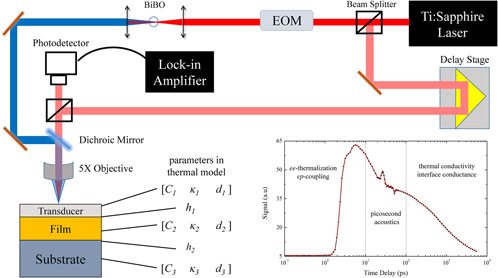Crossref Citations
This article has been cited by the following publications. This list is generated based on data provided by
Crossref.
Viehhauser, G.
2015.
Thermal management and mechanical structures for silicon detector systems.
Journal of Instrumentation,
Vol. 10,
Issue. 09,
p.
P09001.
Braun, Jeffrey L.
King, Sean W.
Giri, Ashutosh
Gaskins, John T.
Sato, Masanori
Fujiseki, Takemasa
Fujiwara, Hiroyuki
and
Hopkins, Patrick E.
2016.
Breaking network connectivity leads to ultralow thermal conductivities in fully dense amorphous solids.
Applied Physics Letters,
Vol. 109,
Issue. 19,
Braun, Jeffrey L.
Baker, Christopher H.
Giri, Ashutosh
Elahi, Mirza
Artyushkova, Kateryna
Beechem, Thomas E.
Norris, Pamela M.
Leseman, Zayd C.
Gaskins, John T.
and
Hopkins, Patrick E.
2016.
Size effects on the thermal conductivity of amorphous silicon thin films.
Physical Review B,
Vol. 93,
Issue. 14,
Wang, L.
Cheaito, R.
Braun, J. L.
Giri, A.
and
Hopkins, P. E.
2016.
Thermal conductivity measurements of non-metals via combined time- and frequency-domain thermoreflectance without a metal film transducer.
Review of Scientific Instruments,
Vol. 87,
Issue. 9,
Pulavarthy, Raghu
Wang, Baoming
Hattar, Khalid
and
Haque, M.A.
2017.
Thermal conductivity of self-ion irradiated nanocrystalline zirconium thin films.
Thin Solid Films,
Vol. 638,
Issue. ,
p.
17.
Park, Moon-Sic
Shim, Hee-Sang
Baek, Seung Heon
Kim, Jung Gu
and
Hur, Do Haeng
2017.
Effects of oxidation states of fuel cladding surface on crud deposition in simulated primary water of PWRs.
Annals of Nuclear Energy,
Vol. 103,
Issue. ,
p.
275.
Khafizov, M.
Chauhan, V.
Wang, Y.
Riyad, F.
Hang, N.
and
Hurley, D.H.
2017.
Investigation of thermal transport in composites and ion beam irradiated materials for nuclear energy applications.
Journal of Materials Research,
Vol. 32,
Issue. 1,
p.
204.
Si, Shuyao
Li, Wenqing
Zhao, Xiaolong
Han, Meng
Yue, Yanan
Wu, Wei
Guo, Shishang
Zhang, Xingang
Dai, Zhigao
Wang, Xinwei
Xiao, Xiangheng
and
Jiang, Changzhong
2017.
Significant Radiation Tolerance and Moderate Reduction in Thermal Transport of a Tungsten Nanofilm by Inserting Monolayer Graphene.
Advanced Materials,
Vol. 29,
Issue. 3,
Wang, Yuzhou
Hurley, David H.
Luther, Erik P.
Beaux, Miles F.
Vodnik, Douglas R.
Peterson, Reuben J.
Bennett, Bryan L.
Usov, Igor O.
Yuan, Pengyu
Wang, Xinwei
and
Khafizov, Marat
2018.
Characterization of ultralow thermal conductivity in anisotropic pyrolytic carbon coating for thermal management applications.
Carbon,
Vol. 129,
Issue. ,
p.
476.
Cui, Shuang
Doerner, Russ P.
Simmonds, Michael J.
Xu, Chuan
Wang, Yongqiang
Dechaumphai, Edward
Fu, Engang
Tynan, George R.
and
Chen, Renkun
2018.
Thermal conductivity degradation and recovery in ion beam damaged tungsten at different temperature.
Journal of Nuclear Materials,
Vol. 511,
Issue. ,
p.
141.
Scott, Ethan A.
Hattar, Khalid
Rost, Christina M.
Gaskins, John T.
Fazli, Mehrdad
Ganski, Claire
Li, Chao
Bai, Tingyu
Wang, Yekan
Esfarjani, Keivan
Goorsky, Mark
and
Hopkins, Patrick E.
2018.
Phonon scattering effects from point and extended defects on thermal conductivity studied via ion irradiation of crystals with self-impurities.
Physical Review Materials,
Vol. 2,
Issue. 9,
Radue, Elizabeth L.
Tomko, John A.
Giri, Ashutosh
Braun, Jeffrey L.
Zhou, Xin
Prezhdo, Oleg V.
Runnerstrom, Evan L.
Maria, Jon-Paul
and
Hopkins, Patrick E.
2018.
Hot Electron Thermoreflectance Coefficient of Gold during Electron–Phonon Nonequilibrium.
ACS Photonics,
Vol. 5,
Issue. 12,
p.
4880.
Riyad, M. Faisal
Chauhan, Vinay
and
Khafizov, Marat
2018.
Implementation of a multilayer model for measurement of thermal conductivity in ion beam irradiated samples using a modulated thermoreflectance approach.
Journal of Nuclear Materials,
Vol. 509,
Issue. ,
p.
134.
Li, Zhenbao
Cao, Yejie
Liu, Wen
Wang, Yiguang
Sun, Fangyuan
Chen, Zhe
and
Zhang, Zhongyin
2018.
Enhanced irradiation resistance and thermal conductivity of SiC induced by the addition of carbon under Au2+ ion irradiation.
Ceramics International,
Vol. 44,
Issue. 7,
p.
8521.
Zinkle, S.J.
and
Snead, L.L.
2018.
Opportunities and limitations for ion beams in radiation effects studies: Bridging critical gaps between charged particle and neutron irradiations.
Scripta Materialia,
Vol. 143,
Issue. ,
p.
154.
Olson, David H.
Braun, Jeffrey L.
and
Hopkins, Patrick E.
2019.
Spatially resolved thermoreflectance techniques for thermal conductivity measurements from the nanoscale to the mesoscale.
Journal of Applied Physics,
Vol. 126,
Issue. 15,
Radue, Elizabeth
Runnerstrom, Evan L.
Kelley, Kyle P.
Rost, Christina M.
Donovan, Brian F.
Grimley, Everett D.
LeBeau, James M.
Maria, Jon-Paul
and
Hopkins, Patrick E.
2019.
Charge confinement and thermal transport processes in modulation-doped epitaxial crystals lacking lattice interfaces.
Physical Review Materials,
Vol. 3,
Issue. 3,
Dennett, Cody A.
Buller, Daniel L.
Hattar, Khalid
and
Short, Michael P.
2019.
Real-time thermomechanical property monitoring during ion beam irradiation using in situ transient grating spectroscopy.
Nuclear Instruments and Methods in Physics Research Section B: Beam Interactions with Materials and Atoms,
Vol. 440,
Issue. ,
p.
126.
Sarkar, Dipta
Brady, Jeffrey
Baboly, M. G.
Xu, Leidong
Singh, Gurpreet
and
Leseman, Z. C.
2019.
1D thermal characterization of micro/nano-cantilevers for Suspended ThermoReflectance measurements.
AIP Advances,
Vol. 9,
Issue. 8,
p.
085315.
Hua, Zilong
Fleming, Austin
and
Ban, Heng
2019.
The study of using a multi-layered model to extract thermal property profiles of ion-irradiated materials.
International Journal of Heat and Mass Transfer,
Vol. 131,
Issue. ,
p.
206.



